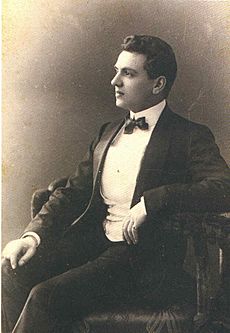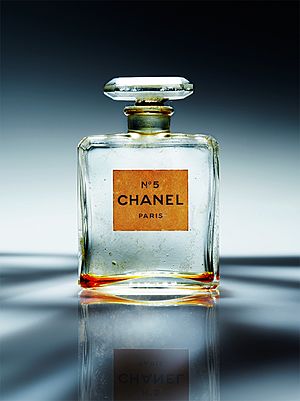Chanel No. 5 facts for kids
Quick facts for kids No. 5 |
|
|---|---|

Bottle of Chanel No. 5, Eau de Parfum version
|
|
| Fragrance by Chanel | |
| Released | 5 May 1921, to select clientele at Chanel, rue Cambon, Paris |
| Label | Chanel |
Chanel No. 5 was the first perfume launched by French couturier Gabrielle "Coco" Chanel in 1921. The scent formula for the fragrance was compounded by French-Russian chemist and perfumer Ernest Beaux. The design of its bottle has been an important part of the product's branding. Coco Chanel was the first face of the fragrance, appearing in the advertisement published by Harper's Bazaar in 1937.
Contents
The No. 5 name
At the age of twelve, Chanel was handed over to the care of nuns, and for the next six years spent a stark, disciplined existence in a convent orphanage, Aubazine, founded by 12th-century Cistercians in the Nouvelle-Aquitaine region of central France. From her earliest days there, the number five had potent associations for her. For Chanel, the number five was especially esteemed as signifying the pure embodiment of a thing, its spirit, its mystic meaning. The paths that led Chanel to the cathedral for daily prayers were laid out in circular patterns repeating the number five.
Her affinity for the number five co-mingled with the abbey gardens, and by extension the lush surrounding hillsides abounding with Cistus (rock roses).
In 1920, when presented with small glass vials containing sample scents numbered 1 to 5 and 20 to 24 for her assessment, she chose the fifth vial. Chanel told her master perfumer, Ernest Beaux, whom she had commissioned to develop a new fragrance, "I present my dress collections on the fifth of May, the fifth month of the year and so we will let this sample number five keep the name it has already, it will bring good luck."
Bottle design
Chanel envisioned a design that would be an antidote for the over-elaborate, precious fussiness of the crystal fragrance bottles then in fashion popularized by Lalique and Baccarat. Her bottle would be "pure transparency...an invisible bottle". It is generally considered that the bottle design was inspired by the rectangular beveled lines of the Charvet toiletry bottles, which, outfitted in a leather traveling case, were favored by her lover, Arthur "Boy" Capel. Some say it was the whiskey decanter he used that she admired and wished to reproduce in "exquisite, expensive, delicate glass".
The first bottle produced in 1922, differed from the Chanel No. 5 bottle known today. The original container had small, delicate, rounded shoulders and was sold only in Chanel boutiques to select clients. In 1924, when "Parfums Chanel" incorporated, the glass proved too thin to survive shipping and distribution. The bottle was modified with square, faceted corners, its only significant design change. In a 1924 marketing brochure, Parfums Chanel described the bottle as, "the perfection of the product forbids dressing it in the customary artifices. Why rely on the art of the glassmaker...Mademoiselle is proud to present simple bottles adorned only by...precious teardrops of perfume of incomparable quality, unique in composition, revealing the artistic personality of their creator." Others claim that the bottle's design was inspired by a whiskey bottle, while some say that the inspiration was drawn from glass pharmaceutical vials. In choosing the design for her perfume's bottle, was looking for something simple, even clinical, to stand apart from the overstated designs customarily seen on the perfume counter.
Unlike the bottle, which has remained the same since the 1924 redesign, the stopper has gone through numerous modifications. The original stopper was a small glass plug. The octagonal stopper, which became a brand signature, was created in 1924, when the bottle shape was changed. The 1950s gave the stopper a bevel cut and a larger, thicker silhouette. In the 1970s the stopper became even more prominent but, in 1986, it was re-proportioned so its size was more harmonious with the scale of the bottle.
The "pocket flacon," designed to be carried in a purse, was introduced in 1934. The price and container size were reduced to appeal to a broader customer base.
The bottle, over the decades, has itself become an identifiable cultural artifact, so much so that Andy Warhol chose to commemorate its iconic status in the mid-1980s with his pop art, silk-screened, Ads: Chanel.
A limited-edition, crimson red crystal glass bottle in the three editions of Chanel No. 5, namely Eau de Parfum, Parfum, and L'Eau, was launched for Christmas in 2018.
The scent
Provenance of the recipe

Coco Chanel had wanted to develop a distinctly modern fragrance for some time prior to early-1920. At this time, Chanel's lover was Grand Duke Dmitri Pavlovich Romanov of Russia, the murderer of Rasputin. The duke introduced her to Ernest Beaux on the French Riviera. Beaux was the master perfumer at A. Rallet and Company, where he had been employed since 1898. The company was the official perfumer to the Russian royal family, and "the imperial palace at St. Petersburg was a famously perfumed court." The favorite scent of the Tsarina Alexandra, composed specifically for her by Rallet in Moscow, had been an eau de cologne opulent with rose and jasmine named Rallet O-De-Kolon N°1 Vesovoi.
In 1912, Beaux created a men's cologne, Le Bouquet de Napoleon, to commemorate the 100th anniversary of the Battle of Borodino, a decisive battle in the Napoleonic Wars. Its success inspired Beaux to create a feminine counterpart, whose starting point was the chemical composition of aldehydic multiflores in Houbigant's immensely popular fragrance, Quelques Fleurs (1912).
His experiments with the aldehydes in Quelques Fleurs, resulted in a fragrance that he called Le Bouquet de Catherine. He intended to use the scent to celebrate, in 1913, the 300th anniversary of the Romanov dynasty. The debut of this new perfume was ill-timed commercially. World War I was approaching, and the tsarina and the perfume's namesake, the Empress Catherine, had both been German-born. Timing and unfavorable associations, combined with Le Bouquet de Catherine's hefty price tag, made it a commercial failure. An attempt to re-brand the perfume, as Rallet N°1 was unsuccessful.
Beaux, who had affiliated himself with the Allies and the White Russian army, had spent 1917–1919 as a lieutenant stationed far north, in the last arctic outpost of the continent, Arkangelsk, at Mudyug Island Prison where he interrogated Bolshevik prisoners. The polar ice, frigid seascape, and whiteness of the snowy terrain sparked his desire to capture the crisp fragrance of this landscape in a new perfume.
Beaux perfected what was to become Chanel No. 5 over several months in the late summer and autumn of 1920. He worked from the rose and jasmine base of Rallet N°1, altering it to make it cleaner, more daring, reminiscent of the polar freshness he had experienced during his war years. He experimented with modern synthetics, adding his own invention "Rose E.B." and notes derived from a new jasmine source, a commercial ingredient called Jasophore. The revamped, complex formula also increased the quantities of orris root, iris root, and natural musks.
The key was Beaux's use of aldehydes. Aldehydes are organic compounds of carbon, oxygen and hydrogen. They are manipulated in the laboratory at crucial stages of chemical reaction whereby the process arrests and isolates the scent. When used creatively, aldehydes act as "seasonings", as aroma boosters. Beaux's student, Constantin Weriguine, said the aldehyde Beaux used had the clean note of the arctic, "a melting winter note". A laboratory assistant, mistaking a full strength mixture for a ten percent dilution, had jolted the compound with a quantity of aldehyde never before used. Beaux prepared ten glass vials for Chanel's assessment. Numbered 1–5 and 20–24, each group a variation of the compound. "Number five. Yes," Chanel said later, "that is what I was waiting for. A perfume like nothing else. A woman's perfume, with the scent of a woman."
According to Chanel, the formula used to produce No. 5 has changed little since its creation, except for the necessary exclusion of natural civet and certain nitro-musks. The Eau de Parfume, though, is a different fragrance from the Parfum and the Eau de Toilette, and was composed in the eighties by Jacques Polge as a modern version of No. 5.
Celebrity ambassadors
- Coco Chanel (1937)
- Suzy Parker (1957)
- Ali MacGraw (1966)
- Jean Shrimpton (1971)
- Catherine Deneuve (1969–1979)
- Carole Bouquet (1986–1997)
- Estella Warren (1998–2000)
- Nicole Kidman (2004–2005)
- Audrey Tautou (2009)
- Brad Pitt (2012)
- Marilyn Monroe (2013)
- Gisele Bundchen (2014)
- Lily-Rose Depp (2016–2019)
- Marion Cotillard (2020–present)
See also
 In Spanish: Chanel n.º 5 para niños
In Spanish: Chanel n.º 5 para niños


